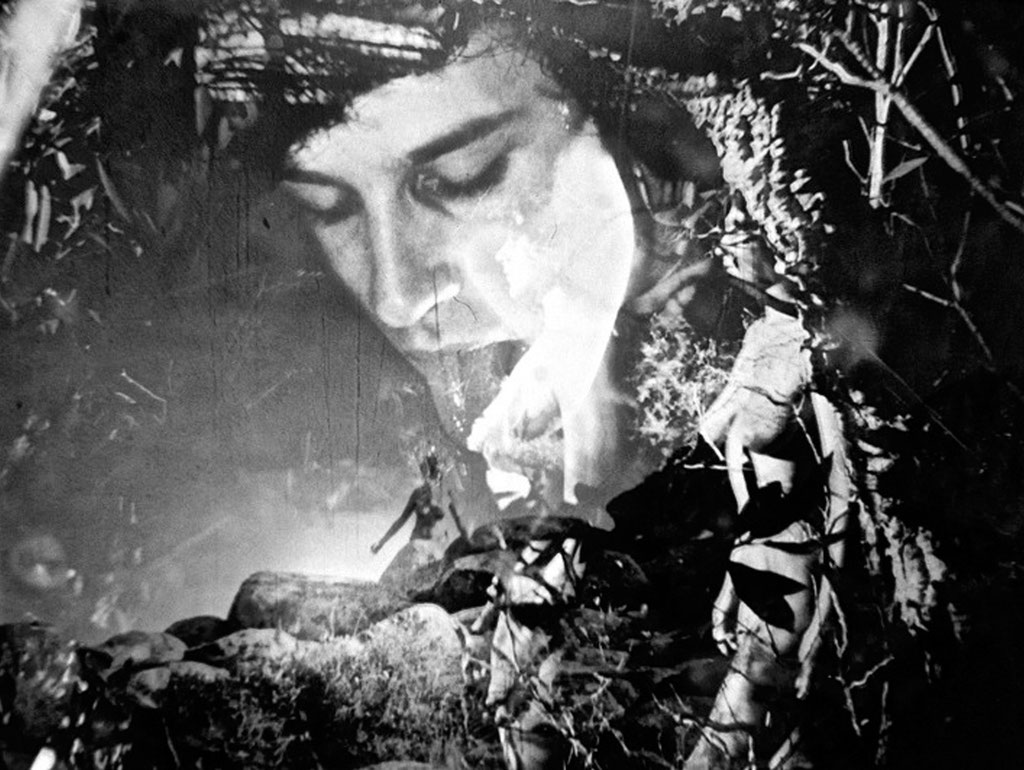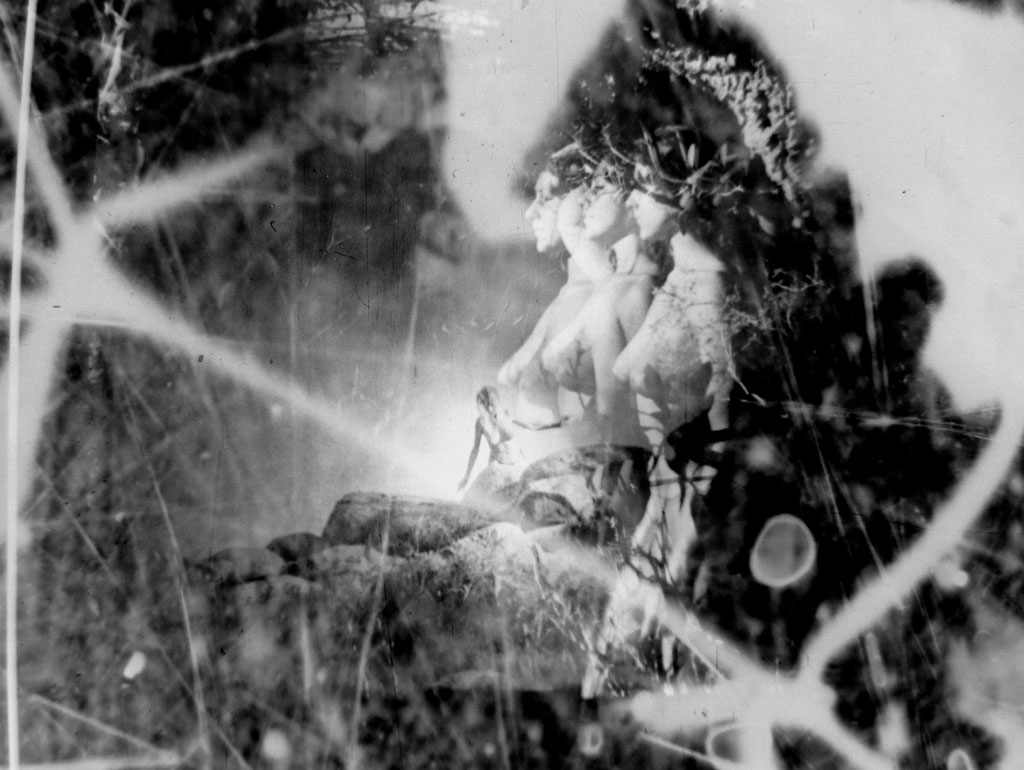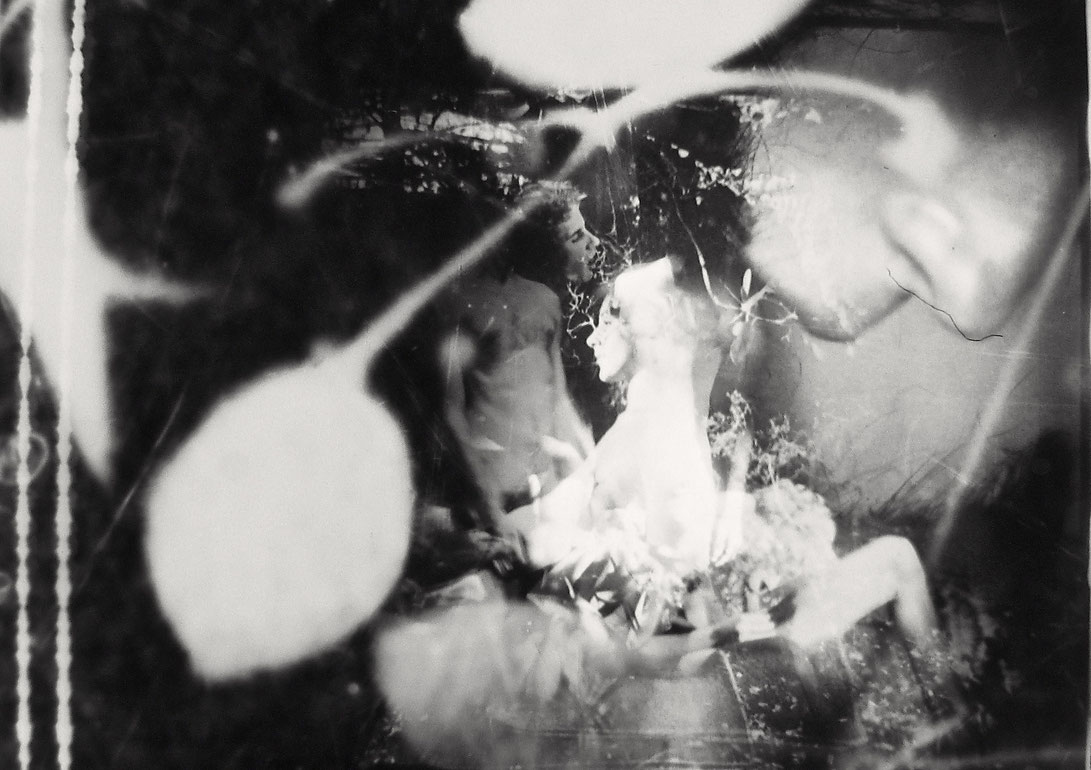The Exquisite Corpus
Trügerisch simpel startet Peter Tscherkassky seine Reise in die Sehnsuchtswelten des sexualisierten Kinos: Ein nacktes Paar, Darsteller eines gefundenen Sixties-Nudistenfilms, besteigt ein kleines Segelboot, gleitet durch schwarz getöntes Wasser, an kahlen Felslandschaften vorbei – und stößt schließlich, an einem entlegenen Strand, auf eine schlafende Schöne.
Erst an diesem Punkt, in Minute vier, brennen die Tscherkassky-Sicherungen in gewohntem Stil durch: Die Bilder beginnen zu flackern und zu zittern, sich in- und übereinander zu schieben, nervös zwischen Positiv und Negativ zu schillern, in Über- und Mehrfachbelichtung und Verdunkelung, in Split-Screen- und Zerreffekte zu stürzen. The Exquisite Corpus – der Titel bezieht sich nicht nur auf die Assoziationskunst der Surrealisten (Cadavre Exquis), sondern auch auf die "schöne Leiche" des fast vollständig verdrängten fotografischen Kinos – ist ein Bild für Bild, streng analog und manuell komponierter Film, gebaut aus Momenten entstellter Spiel-, Amateur- und Pornofilme und Fragmenten verworfener Werbefilmaufnahmen: Magie aus dem Müllcontainer des kommerziellen Films. Dirk Schaefers hypnotischer Soundtrack mischt Motive der Exotica-Legende Les Baxter und Musique concrète, zitiert Teiji Itos berühmten Score zu Maya Derens Meshes of the Afternoon, bringt Originaltöne und manipulierte Filmstimmen ein. Dabei sickert ein untergründiger Humor in die vielfältigen Formspiele und Stile, macht die von Tscherkassky beschworene sanfte Ekstase der Schaulust, des Begehrens, der phantasierten Verführung noch pointierter. The Exquisite Corpus ist ein Trancefilm mit Zug ins listig Animalische, ein feuchter Wachtraum aus Gesichtern, Körpern und Geweben, taktil, textil – ein erotisches Planspiel. (Stefan Grissemann)
Um 1925 entwickeln die Surrealisten in Paris eine Cadavre exquis genannte Schreib- und Zeichentechnik, bei der mehrere Beteiligte gemeinsam eine Zeichnung herstellen oder einen Satz bilden. Dabei schreibt oder skizziert jeder Teilnehmende einen vorher vereinbarten Satz-, bzw. Körperteil, verdeckt das Ergebnis, und reicht das Blatt weiter für den nächsten Teil. Diese Gemeinschaftsarbeiten resultieren in hochgradig synthetischen, phantastischen Bildern oder Sätzen – Compositionen im ursprünglichen Wortsinn: Teile, zusammengefügt.
Den Name erhielt diese Technik vom ersten Satz, der mit ihr gewonnen wurde: "Le cadavre exquis boira le vin nouveau", dt. „Der köstliche Leichnam wird den neuen Wein trinken“, engl. „The exquisite corpse shall drink the new wine.“
Während die meisten meiner Filme aus einer einzigen, oder zumindest einer dominierenden Found-Footage-Quelle gespeist wurden, dienten diesmal, in Referenz zur surrealistischen Mischtechnik des „cadavre exquis“, mehrere unterschiedliche Filme als Ausgangsmaterial. Neben einigen Rushes für Werbefilme waren dies ein amerikanischer Erotikthriller aus den 1980er Jahren, eine britische Komödie aus den frühen 1960ern, ein dänischer und ein französischer Pornofilm (beide vermutlich aus den 1970ern), ein italienischer Softsexfilm von 1979, sowie ein (britischer?) Amateurspielfilm, der sich am ehesten als "Nudistenfilm" bezeichnen ließe: Expliziter Sex spielt keine Rolle, dafür laufen die Darsteller und Darstellerinnen allesamt völlig unmotiviert nackt durch die Landschaft.
Mein Hauptaugenmerk lag auf den zuletzt genannten erotischen Filmen; alle vier verbindet, dass sie eine Geschichte erzählen, die zutiefst hanebüchen ist, was insofern nicht ins Gewicht fällt, da es in der Hauptsache darum ging, den menschlichen Körper nackt zu zeigen. Diese Grundhaltung machte ich mir zu Nutze, indem ich den Körper des Films zum Thema von The Exquisite Corpus erhob.
The Exquisite Corpus beginnt mit einer Suche entlang der Küste eines Meeres. Vom Boot aus sehen wir bereits ein wenig vom Personal des Films. Schließlich stoßen wir auf das Objekt der Suche – eine schlafende Schöne am Strand. Während wir noch die Frau in ihrem Schlaf betrachten, werden wir plötzlich und unvermutet in ihren Traum gezogen. Es ist dies ein Traum voller Ambivalenzen – sinnlich, humorvoll, schauerlich, ekstatisch; insgesamt eine breit angelegte Verführung zur Lust an greifbarer, spürbarer, köstlicher Körperhaftigkeit – auch der des analogen Films.
Neben dem erwähnten Found Footage finden sich quer durch den Film immer wieder indexikalische Zeichen und Bilder einkopiert: Fotogramme natürlichen Ursprungs wie Laub und Blütenstände, sowie als kulturelle Produkte Netze und Häkelarbeiten (crochet works; crochets). Dieses Geflecht aus indexikalischen Abdrücken („Rayogrammen“, wie sie nach Man Ray und dessen Dunkelkammer-Experimenten auch genannt werden) demonstriert nicht nur eine spezifische Möglichkeit der Gestaltung analogen Films, es verleiht der Leinwand auch ein organisches Flair, in das die fotografisch-ikonischen Bilder – die ebenfalls zwischen gemachten Innenräumen und freier Natur changieren – sich über weite Strecken eingebettet finden. Auch Schrift taucht mehrfach inmitten des Bilderreigens auf, und zwar in den Versionen Druckschrift und Handschrift – wie ein Echo auf die Systeme ikonisch (Druck) und indexikalisch (Abdruck).
Diese unterschiedlichen Quellen, aus denen The Exquisite Corpus gespeist wird, führten zu Bruchlinien und Heterogenitäten, die ich im Hinblick auf die surrealistische Technik des „cadavre exquis“ bewusst in Kauf genommen habe. Gleichzeitig spielt der Titel des Films freilich auf den „exquisiten Leichnam“ an, den der analoge Film heute darstellt: ein köstlicher Körper, allerdings versehen mit einem Ablaufdatum. Noch ist dieses Datum nicht genau erkennbar, aber es ist absehbar. (Peter Tscherkassky)
Cannes 2015 by Daniel Kasman
Written by Daniel Kasman
Published on 25 May 2015
https://mubi.com/notebook/posts/cannes-2015-day-10
Trying to capture global trends in contemporary filmmaking by drawing thematic connections between films at the same festival has long been a hackneyed technique that little understands the variable pathways it takes for a film to get made and eventually programmed alongside another. Once one knows more of the tortuous route most filmmakers follow to finish their work and get it shown, the tendrils of affinity or dissonance snaking between theatres and screenings at a festival feel less like a glimpse of the zeitgeist and more the electric charge of coincidence—or fate.
Such was the case in Cannes this year, where two films seemed to meet in a sensual, overlapping dream of flesh, caresses and orgasms. The first dream was formalist extremist Gaspar Noé´s follow-up his untoppable Enter the Void (2009), a new provocation de jour: a 3D sex film. Or, to be more precise, a 3D relationship drama profoundly rooted in the importance sex (unsimulated between his actors) in relationships. Navigating a tuxedoed and high-heeled, rudely fevered and pushily eager crowd at the midnight premiere of Love that eventually started at 1am and ended after 3, the effort and exhaustion required to be provoked did not leave me in a generous mood for this plodding, wooden drama, repetitious and juvenile, yet imbued with an admirable degree of gentleness and affection. I thought, at the time, my patience for any sex in the cinema had been drained completely. But what I hadn´t counted on was that the end of the festival, down the boulevard in an incongruous short film program at the Directors´ Fortnight, projected in a significantly more skeezy cinema than the Grand Théâtre Lumière, though shown at a sunny mid-day time slot far less conducive for sexual-cinematic immersion, I would encounter a far different and better sex film: Austrian avant-garde master Peter Tscherkassky´s The Exquisite Corpus.
I mention Love and The Exquisite Corpus together not to take a glib swipe at Noé´s film, but rather because encountering Tscherkassky´s—a collage of different soft-core, black and white films from the ranging from the 1960s - 1980s named after the surrealist practice of conjoining unconnected things to create uneasy fusions and fission—suddenly made the act of watching these two sex films back to back feel completely fitting. Both structure their stories much in the same way, Love starting with a young man in bed with the mother of his child and flashing back to this his tumultuous recent love life, and The Exquisite Corpus beginning with a nudist couple sailing to a nudist island and finding a girl—nude—asleep or unconscious on the beach, and what follows is her dream. In this cynical and supposedly sophisticated era, where pornography is ubiquitous with access to the Internet, with an image culture that dissipates the charge of photographic nudity, and, in the art film world, where the "audacity," no longer really audacious, of integrating pornographic tropes like unsimulated sex into films is not uncommon; perhaps in this era filmmakers now need such subjective framing devices to properly perfume the sex for the audience with an aura of irreality. We can´t just be shown explicit sex, or drama that includes explicit sex, as these are every day discoveries; we must be led into a world that tells us that while the sex may be real, it is also a fantasy, a memory, a dream—it is something that, outside of your own mind, only cinema itself can magically conjure.
I don´t think Gaspar Noé quite understands what throwing his film into his clod-headed hero´s memories implies or what it allows him to do as a storyteller. Love´s flashbacks are more about a structural interest in relationships and their plotting through time, as in Noé´s Irreversible (2002), rather than what leaving behind "real" time can free a character, a mindstate, a body or a film to do, a freedom his last movie, Enter the Void takes to the max. The Exquisite Corpus, as befits its name, absolutely has this freedom, and it feels it; while Love´s texture is viscously silken, as if we´re stuck in an aquarium of translucent jelly, this 19-minute short, after its prologue arrival on the nudist island, flies into skittering subjective freedom. It moves from clip to clip of soft-core—a forced come-hither smile, a man´s hand caressing a woman´s thighs, the unbuttoning of a fly—and subjects them to Tscherkassky´s characteristic, mad (film-) laboratory manipulations of film stock, radically altering the original footage and/or exposing and playing with its celluloid itself, so in the frame you see multiple strips of the same clip playing in sync, or out of sync—or otherwise treated to maximize the texture of the image and the tactility of film´s movement.
What this does is make the viewing experience haptic, or nearly so; you feel this film, it has not only a physical quality that pulses from the screen but its fitful energy makes this tangibility aggressive and insistent. Depending on the director´s subject, this unique sensation can carry different connotations; Outer Space (1999), for example, finds a link between the assaulting quality of this style on the audience with how Tscherkassky´s manipulations of footage from a horror film seem to also be attacking the film´s heroine, an immersive double onslaught. The Exquisite Corpus is closer to Instructions for a Light and Sound Machine (2005), whose Spaghetti Western source material makes the director´s meticulous, musical manipulations more of a direct cinephilic pleasure. In The Exquisite Corpus, the micro narratives of watching, teasing, touching, fucking and cumming are stories we´re familiar with, and so the play with them, their accentuation, the rhymes or narrative links between footage, their action´s prolongation, the heightened anticipation, all of this carries a more wry edge, downright coy in spots and always a thrill.
Suffice to say, while Love clearly assumes it is being profound, audacious, and heartfelt, The Exquisite Corpus sees the humor and perversion inherent in filming sex—not to mention turning sex or the reason why people are having sex into a story—and dives deep into this world, capturing at once its ridiculousness and the visceral effect it can have, the verve and tantalization it can contain. Tscherkassky is not so much highlighting and excerpting precious bits of soft-core like Godard might quote a lovely gesture from an old film, but rather The Exquisite Corpus pulls at, provokes, and challenges the material these choice moments are made of—quite literally—and finds in their material the ability to express something akin to a super-condensed, supercharged version of their original purpose, all without betraying their woe-begotten cultural value. Suffice to say, I exited the theatre and left Cannes with my faith in sex films restored.
Night Award / Signes de Nuit Bangkok / Jury-statement (Preis (Auszeichnung))
The Night Award honors films, which are able to balance ambiguity and complexity characterized by enigmatic mysteriousness and subtleness, which keeps mind and consideration moving.
Jury Statement :
Introduced as an obscene, amoral, shamelessly self-exposed, only except that it had been done since the year of donkey, Tscherkassky´s latest (and finest) piece of collage as a compilation and accumulation of archival of pornography that secretly and privately screened (more or less presumably) in the forties, otherwise modifies and materialisation to the term "underground cinema", since those obliged to be exclusively exhibited in private space. The real valueless of pornographic adult movies, beside the functions in serving sexual male fantasy, but a fulfillment in manifest our rights of freedom even in our private space, once it´d been regarded as pervert,in our times, those rediscovery of vintage archival of adult movies not only becomes a history, but a fine material to be represented as experimental film. Tscherkassky uses the same techniques that fashionable in the era of avant-gardist experimentalism that tempting
us almost to believe if it had been done by any of those
contemporaries of Man Ray, or Marcel Duchamps.
Night Award / Signes de Nuit Bangkok / Jury-statement



